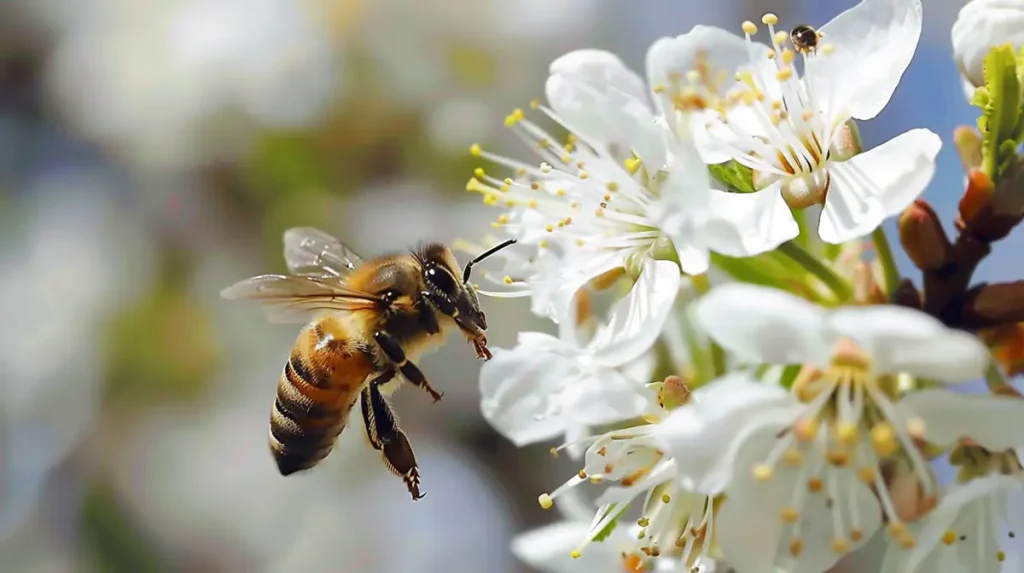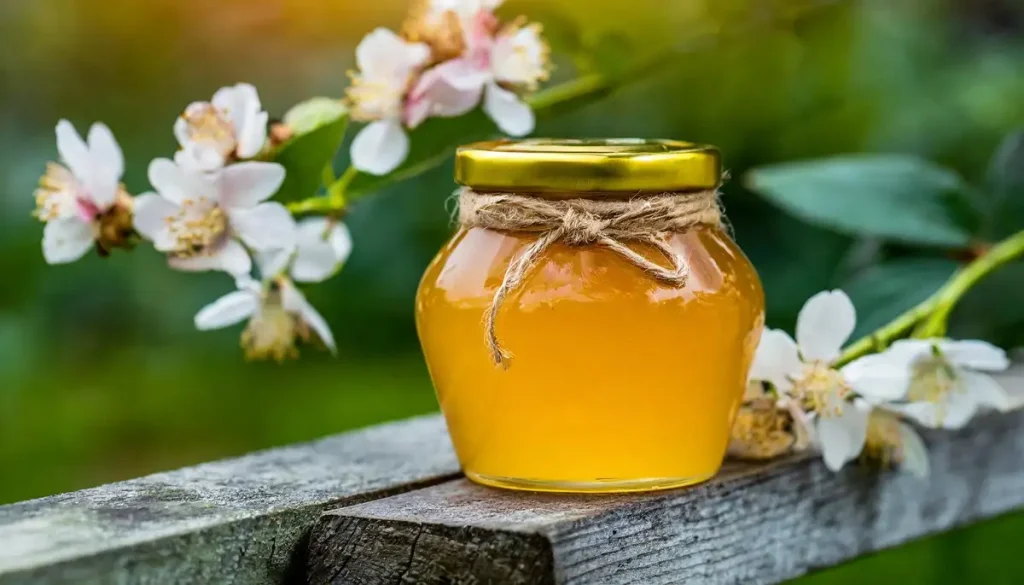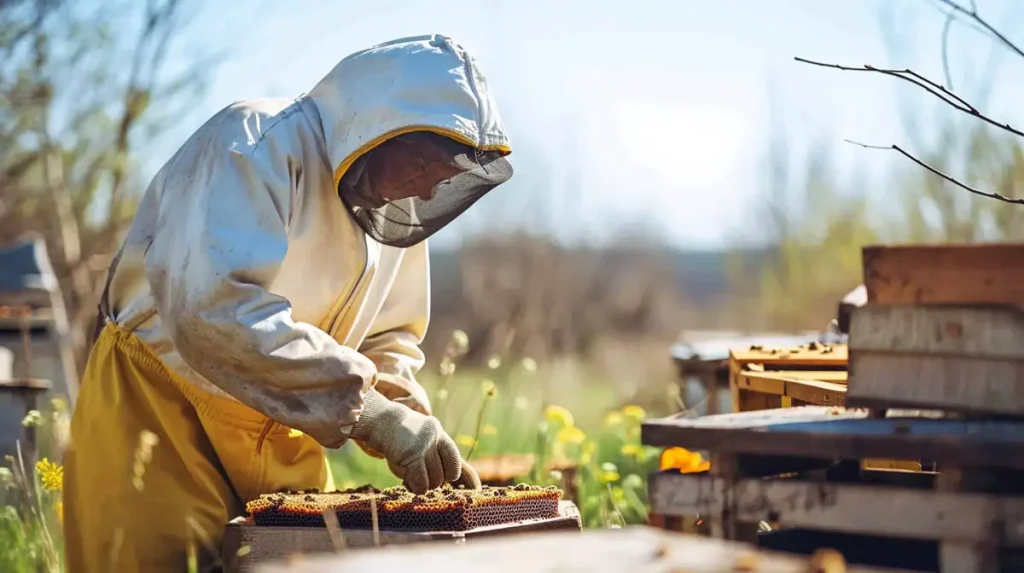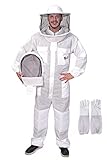Table of Contents
Although bees can and do obviously sting, unlike many other types of stinging insects, they only do so defensively. Nevertheless, almost every beekeeper on the planet will have been stung a few times by the time he or she hangs up the smoker. It is almost inevitable. In saying that though, how do beekeepers not get stung? Well, there are some tips and tricks employed by beekeepers that help to mitigate the issue of bee stings.
This article will look at a few of these. Indeed, I have collated a few tips gathered during my research for this piece and added them to my own tidbits. I go into detail further down, but in summary, here is the list of 18 tips on how beekeepers can avoid being stung (more than they need to):
- Choose a good day for your inspection/collection
- Choose a good time for your inspection/collection
- Attend your hive when the bees are out foraging
- Bees are at their calmest at times of nectar flow
- Do not wear any fragrances
- Do not wear shiny jewelry
- Always wear protective clothing
- Wear light colors
- Always be calm
- Try to avoid sweating on, or breathing heavily onto, the bees
- Do not stand in front of the hive’s entrance
- Always use your smoker
- Be aware of the buzzing
- Avoid bumping the hive if you can because vibrations upset the bees
- If you are removing honey, do it quickly
- Do not swat bees
- Do not run away
- If you do get stung, move away from the hive calmly
So there you have it, my 18 tips to avoid getting stung. In the following paragraphs I will go into a little more detail about each tip, just to clarify what I mean.
1. Choose A Good Day for Your Inspection/Collection
What do I mean when I say choose a good day for your inspection, collection, or any other task you have at your hive)? Well, a good day (indeed, a perfect day) is a warm (not too hot though), sunny day with a high or rising air pressure reading and not windy.
If the weather is too cold, too wet, too windy, or even changeable (think thundery conditions here), you will find that more bees will be in the hive than otherwise would be expected. This obviously raises the risk of being stung.
2. Choose A Good Time for Your Inspection/Collection
Along the same lines as the above tip for choosing a good day, choosing a good time of day is also important. A good time is generally considered between the hours of 10 a.m. and 2 p.m. Before or after these times means more bees will be in the hive. Typically, that 4-hour time slot between 10 a.m. and 2 p.m. is when the foraging bees are out doing their thing. This means that the hive contains less bees, decreasing your chances of being stung as you go about your business.
3. Attend Your Hive When the Bees Are Out Foraging
This third tip is really just an extension of tip number two. The foragers are generally out an hour or so either side of noon. More bees out foraging means less bees at home when you visit. Less chance of being stung.

4. Bees Are at Their Calmest at Times of Nectar Flow
What do I mean by times of nectar flow? I am simply talking about those times when there is an abundance of nectar from lots of different floral sources. Bees are usually calmer when there is an abundant flow.
5. Do Not Wear Any Fragrances
Basically, bees are attracted to strong smells. This doesn’t mean strong smells encourage them to sting, but that attraction could mean more bees around you than normal investigating the smell, increasing the potential for stings. Perfumes, aftershaves, strong deodorants, hairspray, some heavy soaps, and other strongly scented products should all be avoided unless you want to become a bee magnet. Conversely, body odor can also attract the bees, so bathe or shower but don’t overdo the scented stuff.
I also came across the following tip in relation to smells: apparently bananas emit a smell that is very similar to the bee’s alarm pheromone when they are on high alert and become defensive. It is probably best then to avoid eating bananas before visiting your hives.
6. Do Not Wear Shiny Jewelry
Bees are attracted to shiny objects glistening in the sunshine. Another bee magnet. Lose the shiny jewelry and avoid lots of bees investigating and the potential for getting stung.
7. Always Wear Protective Clothing
Probably the most obvious of all the tips, but there are some beekeepers that are very blasé about their protective clothing, donning the bare minimum. If you want to avoid stings, suit up. This means a full bee suit along with veil and gloves.
- Carter, Anthony (Author)
- English (Publication Language)
- 194 Pages - 02/28/2024 (Publication Date) - Independently published (Publisher)
There are so many types and designs of bee suit on the market, each offering different amounts of body coverage and, hence, protection. From the complete suits that will cover all of the body to the half suits that protect the upper torso and arms, there is something for all tastes. Be aware though. A bee can still sting through a bee suit when conditions are just right, and the stars align but wearing a suit does decrease the chance of stings dramatically.
A veil will protect the head and face and its design is such that the fabric will be away from the head and face to avoid those star-aligning stings. The last thing you want is a sting on the face, which can be both very uncomfortable and extremely dangerous. The veil has a mesh front to it so that the wearer can both see and (more importantly!) breathe.
The gloves protect both the hands and the lower arm and are made from a variety of materials.
8. Wear Light Colors
Bees feel less threatened by lighter colors than they do darker ones. So if you wear dark clothing your bees could perceive you as a threat. This is the reason that beekeeper suits and other protective clothing are predominantly white.
9. Always Be Calm
A great habit to get into as a beekeeper is to learn how to be calm around your bees and beehives. Bees respond to calmness with calmness of their own. Going in like a heard of elephants will obviously upset this calmness and your bees will become agitated. With this agitation will be a noticeable uptick in both buzzing volume and bees that become airborne. All this increases the risks of being stung.
So basically, no sudden movements and no sudden noises. Bees are especially sensitive to vibrations as well, so avoid knocking into, bumping into, or otherwise dropping anything onto, the hives. Be calm and gentle and your bees will, for the most part, reciprocate.
10. Try to Avoid Sweating On, Or Breathing Heavily Onto, The Bees
If you are tending your hives on a warm, humid kind of day, be careful with perspiration trickling off your face and into the hive. Bees will not take too kindly to your sweat falling onto them.
Breathe normally when around your beehives but avoid breathing directly onto a frame from quite close. Bees can be sensitive to the CO2 you emit in breath, possibly perceiving it as a threat and ergo heightening their aggression.
11. Do Not Stand in Front of The Hive’s Entrance
Bees typically have well-established flight patterns that help to guide them back to the entrance of their hive. If something blocks this entrance – so your body, in this case – they will quickly become agitated. You might find that they start flying quite close to you as a means of ‘warning you off’; some might even ‘ram’ you. In this situation, heed the warning to avoid some stings.
12. Always Use Your Smoker
Probably the beekeeper’s best defense against stings of all – the smoker. When you smoke a beehive, the bees apparently perceive this as an impending fire close to the hive. The ‘evacuation’ instinct is preceded by the need to gorge to fill up on the nutrients they will need if a ‘new home’ is required, as this would not have any honey.
The gorging has the effect of putting the bees into the equivalent of a bee food coma where they become rather lethargic and therefore less aggressive.
Basically, smoking has the effect of calming the bees. Just be sure not to over-smoke the hive.
13. Be Aware of The Buzzing
In essence, the louder the buzz level, coupled with greater activity among the bees, could indicate agitation. Moving away from the hive for a few minutes could be in order at this stage (or giving another puff of smoke if you had previously used the smoker to calm the bees).
14. Avoid Bumping the Hive If You Can Because Vibrations Upset the Bees
See tip number nine for the reasons to avoid bumping into the hive. Bees do not like sudden vibrations.
15. If You Are Removing Honey, Do It Quickly
If your business of the day is removing honey, make sure this task is done as quickly as possible to avoid unnecessary angst within the hive. Also ensure that all bees have been removed from the frame you are working with. The last thing you want is for an attached bee to send out distress pheromones that the rest of the colony pick up on and ‘come to the rescue’ in a large swarm. Not good if they follow you into your shed or house.

16. Do Not Swat Bees
No matter how hard the temptation, do not swat at bees. Doing so doesn’t have the desired outcome you think you are going to get. Indeed, swatting only gets the bee(s) agitated and hence more aggressive. And do not even think about swatting and running. See below.
17. Do Not Run Away
You cannot outrun a bee. Bees can reach flying speeds of up to 18 miles per hour. You will not be able to run faster than that. Be calm and move away slowly when the bees are getting agitated.
18. If You Do Get Stung, Move Away from The Hive Calmly
If you do happen to get stung, then the first thing to do would be to move away from the hive calmly (reasons above). You will then need to deal with the sting. For the most part, although stings can be quite painful, they are relatively harmless. You will need to remove the stinger as quickly as possible to minimize the amount of bee venom injected into you. The best way to do this is scrape it away.
Do keep an eye out for any possible reactions though. As mentioned above, stings are usually harmless and ‘only’ entail a bit of pain and some local swelling for a day or two. Anything above and beyond this should be an indicator to seek out some medical help in case you have suffered an adverse reaction.
Beekeeping Disclaimer:
Beekeeping, like any agricultural activity, involves inherent risks. It is important to understand these risks and take appropriate measures to mitigate them.
Potential risks associated with beekeeping include:
- Bee stings: Honey bees are generally not aggressive but can become defensive if they feel threatened or their hive is disturbed. Bee stings can cause allergic reactions or even anaphylaxis in some individuals, which can be life-threatening. It is important to wear protective clothing and follow best practices when handling bees to minimize the risk of stings.
- Diseases and pests: Bees can be vulnerable to various diseases and pests, including mites, viruses, and bacterial infections. These can have significant impacts on bee colonies, leading to reduced honey production or even colony collapse. It is important to monitor hives regularly and take appropriate measures to prevent and treat diseases and pests.
- Weather conditions: Extreme weather conditions, such as drought or cold temperatures, can affect the health and productivity of bee colonies. It is important to ensure that hives are appropriately sheltered and provided with adequate food and water.
- Environmental hazards: Bees can be affected by environmental hazards such as pesticide exposure, pollution, and habitat loss. It is important to be aware of these hazards and take appropriate measures to protect bee colonies and promote healthy environments for bees.
- Legal requirements: Beekeeping may be subject to local, state, or national regulations, such as registration or inspection requirements. It is important to be aware of these requirements and comply with them.
While beekeeping can be a rewarding and enjoyable activity, it is important to be aware of the potential risks and take appropriate measures to mitigate them. By following best practices and staying informed about the latest developments in beekeeping, beekeepers can help ensure the health and productivity of their hives and contribute to the well-being of bee populations worldwide.
Last update on 2024-04-17 / Affiliate links / Images from Amazon Product Advertising API




